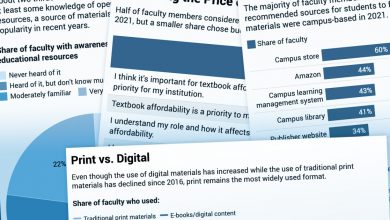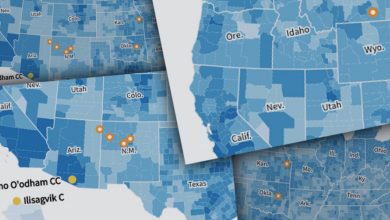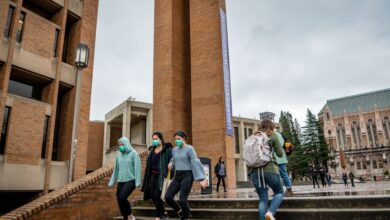What’s Behind the Surge in No-Confidence Votes?

[ad_1]
Anyone following higher-education news in recent weeks has probably noticed a lot of votes of no confidence.
Faculty Senate bodies at two campuses in the University of Maine system voted no confidence in the system chancellor, Dannel P. Malloy. Faculty members at Piedmont University, in Georgia, and Sonoma State University, in California, cast no-confidence votes in their presidents. So did members of the Academic Senate at California State University at Los Angeles. At the University of Illinois at Springfield, the provost was the subject of a vote of no confidence. And at Henderson State University, in Arkansas, the Faculty Senate’s no-confidence vote in the chancellor requested his “immediate dismissal.”
In 2021, at least 24 institutions saw no-confidence votes in their leaders. That may seem like small potatoes, given the thousands of higher-education institutions operating in the United States. But according to data reviewed and compiled by The Chronicle, that’s the highest number in recent history. Seven years out of the last eight have seen the highest number of no-confidence votes recorded.
Claiming its origins in the British Parliament, the no-confidence vote has become a mechanism for faculty bodies to express their dissatisfaction with the people who run their institutions — and, increasingly, with things that aren’t people at all. How effective are such votes? What do they say about the state of the faculty? And what do they really signify?
A common assumption about the apparent rise of the no-confidence vote is that it’s just another example of a restive — or overly reactive — faculty, says William G. Tierney, a university professor emeritus at the University of Southern California and founding director of its Pullias Center for Higher Education.
“People always say the faculty are always upset, and I think that’s true; the faculty are always upset,” Tierney says. “But today it’s much more difficult.”
The conditions that tend to spark a vote of no confidence, Tierney says, are more prevalent now than they were 30 years ago. Particularly in the pandemic era, when budget troubles have led to salary freezes, layoffs, and restructuring and retrenchment, faculty members have had more reason to lose faith in their leaders. “I’m not necessarily blaming presidents,” Tierney added. “I’m just saying that’s the environment we exist in today.”
Evidence also suggests that the duration of a college presidency has in recent years become markedly shorter. According to 2017 data from the American Council on Education, which produces its American College President Study every five years, college presidents had served in their current positions for 6.5 years on average, down from seven years in 2011 and 8.5 in 2006.
“These aren’t the giants of the past who ran our nation’s universities for decades at a time,” says Sean A. McKinniss, a consultant and graduate of the Ph.D. program in higher education and student affairs at Ohio State University whose data was the basis for the Chronicle’s analysis. Greater turnover, he says, tends to create something of a leadership vacuum; leaders who don’t stay in their posts long term may have less opportunity to build trust with the faculty or to embed themselves in an institution’s culture.
In fact, some leaders may start on the job with little knowledge of the inner workings of academe because they’ve come from the worlds of business or politics, or they have a track record of raising money or cutting expenses. Those presidents might feel like they’re playing catch-up, as compared with their colleagues who’ve spent their entire careers in the academy. And — fairly or not — when considering a no-confidence vote, academic lifers might be less inclined to give an outsider the benefit of the doubt than they would one of their own.
How a president was selected may matter, too. Less faculty input in presidential-search processes can engender votes of no confidence in a president’s performance down the road, says Mark Criley, a senior program officer in the American Association of University Professors’ Department of Academic Freedom, Tenure, and Governance.
In a 2021 AAUP shared-governance survey, 7.4 percent of 396 respondents said a vote of no confidence had been taken in an administrator at their institution in the last three years. While the association doesn’t have historical data with which to compare, that number strikes Criley as significant. “It seems like a lot of institutions to me,” he says. But, he added, the number stands to reason, particularly amid the pandemic. “This is a watershed moment for governance,” he says, and in such a climate, no-confidence votes might proliferate.
With uncertainty on the rise, along with threats to faculty power and jobs, “really the only arrow you have in your quiver is no confidence,” Tierney says. “When you don’t have trust, we then rely on formalities, and votes of no confidence are the ultimate formality.”
‘Impressive Odds’
Do no-confidence votes accomplish anything? About 51 percent of the time, a president who has been on the receiving end of one winds up leaving office within a year, according to a Chronicle analysis of more than 235 no-confidence votes dating from 1989 to the present.
“If a faculty’s goal is to oust a leader, those are impressive odds,” says McKinniss, whose database is based on a tally of votes that were covered in the press. But those departures are rarely linked — publicly, at least — to the no-confidence votes. “We always joke that they always use human-resources language: leaving ‘to pursue other interests’ or ‘to be with family’ or ‘for personal health’ and so forth,” McKinniss says. “But the fact is that they’re gone after a vote.”
If no-confidence votes have become more common in the last decade, say McKinniss and Mae Kuykendall, a law professor at Michigan State University with whom he is writing a book about the phenomenon, it’s not because faculty members have become more willing to hold the votes. It’s that they more often feel driven to do so.
“The fact is,” Kuykendall says, “faculty members are risk-averse, and it takes a lot to get them to do something like this.”
A lot, she adds, over time. No-confidence votes often aren’t predicated on a single bad action by a leader, but instead are a result of faculty dissatisfaction that’s festered for months or years. The reasons cited for the votes, she and McKinniss note, fall into general categories, among them financial mismanagement, a president’s failure to participate in shared governance, and interpersonal friction.
On a deeper level, no-confidence votes reflect a failure of shared governance at institutions of all types, say Criley and Tierney.
“Everybody would agree that that votes of no confidence are a last resort,” Criley says. “In order to know that the faculty has no confidence in the president, you would expect the faculty to have done all that they can to try to make the situation work and to try to conduct the business of the university through its normal shared-governance structures.”
No-confidence votes may be more likely to be employed at smaller institutions that aren’t as well endowed, McKinniss says, but there are also plenty of cases at higher-profile institutions. Take, for example, the Harvard University Faculty of Arts and Sciences’ 2006 vote of no confidence in the institution’s then-president, Lawrence H. Summers. “I think that was, for many institutions, the green light to say, ‘All right, if they can do it at Harvard, well, surely we could do it here,’” McKinniss says.
And so, the no-confidence vote remains a potent statement of dissent, and one university leaders fear. Even if they weather the vote and stay at their institution — a significantly easier task if they have the support of the board of trustees — they’re often forced to operate in damage-control mode, says LaWanda W.M. Ward, an assistant professor of higher education at Pennsylvania State University.
“Once that conversation starts about you, instead of taking care of the business of the institution, now you’re working really hard to address the concerns of the faculty,” Ward says, “and also being hopeful that the board of trustees is not on board with the faculty, because then you likely know your time is coming close to an end.”
They might produce public-relations headaches in the short term, but no-confidence votes also mark a permanent blemish on an administrator’s record. Those seeking employment at another institution can expect to field questions from a hiring committee about why their constituents were moved to make such a statement of dissatisfaction. Malloy, of the University of Maine, recently said he would require candidates for president and provost positions to declare whether they’d ever been the subject of a no-confidence vote.
Malloy also gave a sense of the weight such votes can carry for those on the receiving end of them. He said in a statement that he was sorry his actions and decisions had prompted the votes to be passed, adding, “I take this as a matter of immediate urgency.”
A Widening Scope
In recent months, a new kind of no-confidence vote has made headlines. Instead of focusing on a single administrator, faculty bodies have passed votes against entire administrations, boards of trustees, restructuring plans, budget cuts, curricula, presidential candidates and searches, and institutions’ handling of Covid-19.
While no-confidence votes don’t have any binding power, they could easily become “part of the legal narrative” in the Covid era, says Ward, who is also a lawyer. Imagine a faculty member whose institution required her to teach face to face and who was denied an exemption. “After I’ve exhausted all the university policies and procedures and I file a lawsuit, definitely part of my narrative would be: ‘There’s a vote of no confidence about this administration’s handling of Covid-19. My situation is just one of many,’” Ward says.
Votes with more-abstract subjects may have surfaced on occasion before 2020, but they’re largely a product of the Covid-19 era, Ward says. Even though votes of no confidence are traditionally taken against a person, the use of the term in atypical contexts makes a certain amount of sense, Ward says, because it’s a familiar phrase that carries a negative connotation and sense of solemnity. It’s also likely to get media attention, and during the pandemic, no-confidence votes in Covid-mitigation efforts helped draw attention to concerns about students’ and faculty and staff members’ health and safety.
But attention alone shouldn’t be the goal, says Kuykendall: “It might kick off some public discourse, but I can’t see it as having the clout that a vote of no confidence directed at a problematic person has.” Prompting conversation should be the goal of such efforts, she says; replacing an entire administration, board, or policy isn’t realistic.
She and McKinniss believe that the institution of the no-confidence vote hasn’t lost any of its power in recent years. But if these more-abstract votes continue, and broaden even further in scope, they might.
“It’s one thing to hold a no-confidence vote against a president or a dean or a provost and so forth. But if faculty start holding these votes against boards or policies or things like that, I wonder if that route might create more doubt and skepticism,” McKinniss says, before conjuring a (mostly) facetious potential next step. “What if we have a no-confidence vote in the parking arrangements, or a no-confidence vote in the quality of food in the cafeteria?”
Deeper Issues
If no-confidence votes are suffering from mission creep, that may be because there isn’t much of a process for passing one. Nowhere in Robert’s Rules of Order, the playbook by which faculty bodies operate, are no-confidence votes mentioned. The AAUP doesn’t have explicit standards on them, Criley says; nor, as far as he knows, have any higher-education institutions established policies on no-confidence votes in their own regulations.
That means that the process of taking up a no-confidence vote is, largely, reinvented each time it happens. “A lot of people are just kind of making it up, for better and for worse,” says Demetri L. Morgan, an assistant professor of higher education at Loyola University Chicago.
That includes Morgan and his own faculty colleagues. In 2017, tenure-track faculty members in Loyola Chicago’s School of Education passed no-confidence votes in their dean and associate dean. Morgan, then in his first year at Loyola, remembers researching the history and procedure of no-confidence votes as his colleagues considered bringing theirs. He found little scholarly literature to refer to, and no centralized database of no-confidence votes and their efficacy. Instead, he tried to “piece together an overarching narrative” from blogs and local newspaper coverage.
That informal study left many questions for Morgan and his school. Who would be allowed to participate in the vote? To whom would the results be delivered? (Because the main Loyola vote was taken against the dean of the education school, it wasn’t forwarded to the Board of Trustees, as a vote against a university-wide leader might be, but instead to the provost, who had hired the dean.) How could those who were voting best cite as their criteria the dean’s handling of academic matters — which is the faculty’s domain — and not make ad hominem assertions about her leadership style or personality?
Ultimately, the education dean was reassigned. By that measure, one might consider the no-confidence vote to have been successful. But five years on, the problems that drove the vote still haven’t been fixed. “We’re no better for it, process- and policy-wise,” Morgan says. Not only that, but the vote sowed discord in the school. Several faculty members left in the aftermath, and a host of interpersonal issues remained. Morgan thinks that result isn’t unique to this institution, either. “I would suspect the reason we see this sort of never-ending wheel is because we’re not actually fixing the issues,” he says. “We’re just swapping people.”
In such cases, he says, a no-confidence vote is the least of the institution’s worries. It’s the systemic breakdowns that led to a vote in the first place.
[ad_2]
Source link






